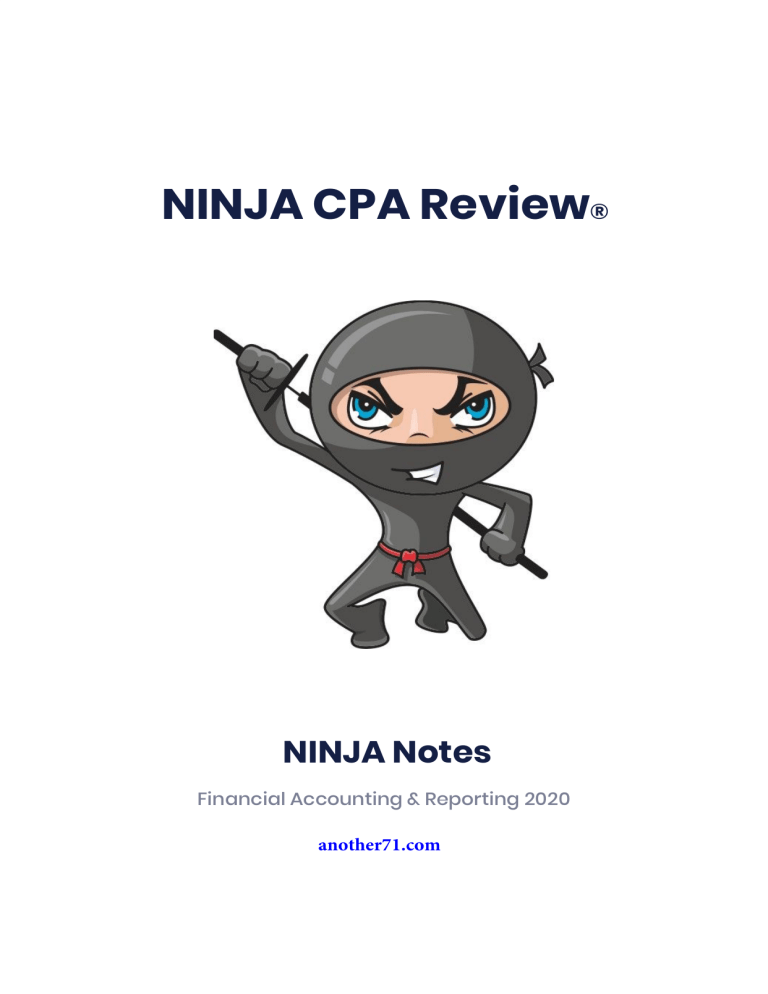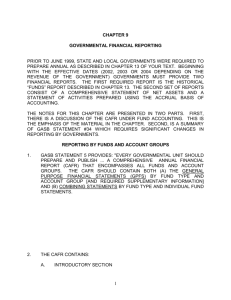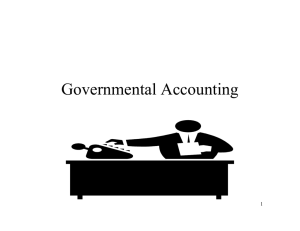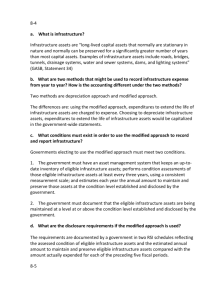
NINJA CPA Review® NINJA Notes Financial Accounting & Reporting 2020 another71.com 2020 FAR Source: AICPA Content Area Allocation Area I Conceptual Framework, Standard-Setting and Financial Reporting 25-35% Area II Select Financial Statements Accounts 30-40% Area III Select Transactions 20-30% Area IV State and Local Governments 5-15% Skill Levels Evaluation The examination or assessment of problems, and use of judgment to draw conclusions. Analysis The examination and study of the interrelationships of separate areas in order to identify causes and find evidence to support inferences. Application The use or demonstration of knowledge, concepts or techniques. Remembering and Understanding The perception and comprehension of the significance of an area utilizing knowledge gained. 2 Table of Contents The N.I.N.J.A. Framework I. IFRS 6 II. Accounting Changes 16 III. Financial Reporting 17 IV. Bonds & Debt Restructure 43 V. Consolidations 51 VI. Deferred Taxes 54 VII. Investments & Derivatives 56 VIII. Fixed Assets 63 IX. Governmental Accounting 69 X. Segments & Interim Reporting 83 XI. Partnership Accounting 85 XII. Inventory 88 XIII. Leases 95 XIV. Current Assets & Liabilities 101 XV. Not-For-Profit Accounting 104 XVI. Pensions 110 XVII. Statement of Cash Flows 112 XVIII. Stockholders’ Equity 115 3 How to use NINJA Notes Reading You've invested in NINJA Monthly, now let the NINJA Notes go to battle for you. You should read them as many times as possible. Carry it with you wherever you go. Simply load the PDF onto your mobile device, and if you have 5 minutes of downtime, you have 5 minutes of study time. It is recommended that you read the NINJA Notes at least five times leading up to your final two weeks of exam prep. If you have 6 weeks to study, then you need to complete this in 4 weeks. 5 weeks to study, then complete it in 3. 4 weeks = 2 weeks. You get the picture. The point is: plan, plan, plan and budget, budget, budget, budget because exam day is looming. Learning Plans 6-Week Plan ● ● ● Approx. 122 pages x 5 reads 4 weeks 7 days per week = Approx. 22 pages per day 5-Week Plan ● ● ● Approx. 122 pages x 5 reads 3 weeks 7 days per week = Approx. 29 pages per day 4-Week Plan ● ● ● Approx. 122 pages x 5 reads 2 weeks 7 days per week = Approx. 44 pages per day 3-Week Plan ● ● ● Approx. 122 pages x 5 reads 1 week 7 days per week = Approx. 87 pages per day 4 Re-Writing The NINJA Notes This step is optional, but it won over a lot of skeptics with its results. This is not mainstream advice. This is the NINJA way. The mainstream way of studying for the CPA Exam is old-fashion and outdated. Forget the old way. You are a NINJA now. Now is the time to either: 1. Re-write your own CPA Exam notes or 2. Re-Write the NINJA Notes. Plan on investing a week doing this, and you should expect to get through at least 20 pages a day to stay on track. 5 IX. Governmental Accounting Governmental Accounting Basics ● Primary Objective ○ Provide information that is useful and benefits a wide range of users including ■ Cost of Services provided ■ Sufficiency of Revenues to cover costs ■ Financial Position of the Entity ● GAAP Hierarchy for State & Local Governments ○ Authoritative ■ Category A ● GASB Statements ■ Category B ● GASB Technical Bulletins ● GASB Implementation Guides ● GASB-Approved AICPA Literature ○ Non-Authoritative ■ GASB Concepts Statements ■ FASB Pronouncements / Other ● Fund Types ○ Governmental Funds ○ Proprietary Funds 69 ○ Fiduciary Funds ● Fund Accounting - Two Types ○ Accrual Basis ■ Current Economic Resources Focus ■ Revenues recognized when earned ○ Modified Accrual Basis ■ Current Financial Resources Focus ■ Revenues recognized when available & measurable ● Budget Estimates ○ Appropriation ■ Highest amount allowed for an expenditure ○ Encumbrance ■ Records purchases & reserves it ● Budget Actuals ○ Expenditure ■ The actual cost of something ● Opening Budgetary Entry Dr Estimated Revenues Control Cr Appropriations Control Dr/Cr Budgetary Fund Balance (plug) ● Closing Budgetary Entry Dr Appropriations Control Dr/Cr Budgetary Fund Balance (plug) Cr Estimated Revenues Control 70 Governmental Funds (GSP-CD) ● Use Modified Basis of Accounting ● Have a Current Financial Resource Focus ● Revenue Recognized when available and measurable ○ Sales tax revenue to be received within 60 days of the fiscal year-end that will be used to fund expenditures made prior to year-end are treated as revenue in the current fiscal year ● General Fund ○ The “Operating” fund of the governmental unit ■ Records Significant Revenues ● Taxes ● Tickets ● Fines ● Licenses ■ Records Significant Expenditures ● Police ● Education ● Fire Dept. ● Special Revenue Fund ○ Restricted for a specific purpose such as street repair ● Permanent Fund ○ Legally restricted 71 ○ Only earnings can be used to fund programs ○ Principal remains intact ● Capital Projects Fund ○ Used to acquire and build facilities ● Debt Service Fund ○ Handles repayment of long-term debt and related interest ● Governmental Fund Balance Types ○ Restricted – Restricted by Contributor (Strict) ○ Committed – Restricted by Government (Less strict because they can undo the restriction) ○ Assigned – Intended to be used for a purpose ○ Unassigned – Available to be spent ○ Non-Spendable – isn’t in a “spendable” state (Inventory) ● Governmental Fund Statements ○ Balance Sheet ○ Statement of Revenues, Expenditures, and Changes in Fund Balance ● Revenue Recognition ○ Is it available? ○ Is it measurable? ○ If yes – it’s revenue, regardless of when it is spent ● Derived Tax Revenue 72 ○ Collected by people “doing” things ■ Buying cars ● Sales Tax ■ Going to work ● Income Tax ● Imposed Tax Revenue ○ Assessed just because things “exist” ■ Property Tax on car ● Your car could sit in the driveway all year and never move. The fact that it exists means it gets taxed ■ Real Estate Tax ○ Recorded as Revenue when Budgeted Proprietary Funds ● Use Accrual Basis of Accounting ○ Orientation is Income Determination ● Have an Economic Resource Focus ● Revenue Recognized when earned and measurable ● Internal Service Fund ○ Serves the needs of other governmental units ○ Example: Motor Pool fixes government vehicles ● Enterprise Fund 73 ○ Provides goods or services to external users ○ Example: Post Office ● Proprietary Fund Financial Statements ○ Statement of Net Position ○ Statement of Revenues, Expenses, and Changes in Net Assets ○ Statement of Cash Flows Fiduciary Funds ● Use Accrual Basis of Accounting ● Have an Economic Resource Focus ● Custodial Fund ○ Government acts as a custodian ● Pension Trust Fund ○ Government is a trustee for a pension plan ● Investment Trust Fund ○ Government is trustee over a series of investments ● Private Purpose Trust ○ Trust that benefits various individuals and entities ● Fiduciary Fund Financial Statements ○ Statement of Fiduciary Net Position ○ Statement of Changes in Fiduciary Net Position 74 Investment & Liability Valuation ● Fair Value ○ Price received to sell an Investment ■ Held for Income or Profit ○ Price paid to transfer a liability ● Valuation Approaches ○ Market Approach ■ Price from similar transactions ○ Cost Approach ■ Price to replace similar asset ○ Income Approach ■ Converts future cash flows to current amounts ■ Example: Present Value Technique ● Fair Value Hierarchy ○ Level 1 (Best) ■ Quoted Prices for Same Assets & Liabilities ○ Level 2 ■ Quoted Prices for Similar Assets & Liabilities ○ Level 3 ■ Best Data Available ● Acquisition Value ○ Price paid if purchased instead of donated 75 ■ Donated Assets ■ Donated Art ● Investment & Liability Disclosures ○ Organized by Asset & Liability Type or Class ○ Fair Value Measurement ■ Valuation Technique ● Change in Valuation Technique? ■ Level of FV Hierarchy used Government-Wide Financial Statements ● Statement of Net Position & Statement of Activities ○ Prepared on an Accrual Basis ○ Focus is on Economic Measurement ○ Purpose is to provide Operational Accountability ● Statement of Net Position ○ Assets (Current & Non-Current) ■ Ordered by Liquidity ○ Deferred Outflows of Resources ■ Future use of Net Assets ■ Exam Tip – Which MCQ option is an example of cash leaving the entity? 76 ■ Exam Tip – D. Outflows follows Assets in presentation (Assets – Outflows – Liabilities – Inflows) because it’s going to use those assets. ○ Liabilities (Current & Non-Current) ■ Ordered by Liquidity ○ Deferred Inflows of Resources ■ Future increase in Net Assets ■ Exam Tip – Which MCQ option is an example of cash entering the entity? ■ Exam Tip – D. Inflows follows Liabilities in presentation … think of it as bringing in money (Inflow) and now you owe a service ○ Restricted Net Assets ○ Unrestricted Net Assets ○ Divided into ■ Government Activities ■ Business Activities ○ Capital Assets are shown Net of Debt ■ NEW: Interest Costs incurred before the end of the construction period are now expensed as incurred ● Intended to enhance the usefulness of the financial statements by showing the cost of borrowing vs capitalizing and including it with the asset cost and amortizing over time 77 Asset Cost - Accumulated Depreciation - Asset Liabilities Net Assets ○ Infrastructure ■ Modified Approach ● Reported at Cost ● No Accumulated Depreciation ● Statement of Activities ○ Government activities divided by function ○ Revenues ■ General Revenues ■ Program Revenues ● Notes to Financial Statements ○ Notes are considered part of Financial Statements ● Presentation ○ If the activities of a component are distinguishable from the rest of the governmental entity, then Discrete Presentation is required ○ If the activities of the component cannot be identified and separated from the rest of the governmental activities, then Blended Presentation is warranted. ○ Component units are reported in the Entity-Wide Financial Statements and not the Fund Financial Statements. 78 Defined Benefit Pension Plans ● Financial Statements Required ○ Statement of Fiduciary Net Position ■ Assets ■ Deferred Outflows ■ Liabilities ■ Deferred Inflows ■ Fiduciary Net Position ○ Statement of Changes in Fiduciary Net Position ■ Additions ● Contributions ● Net Investment Income ■ Deductions ● Benefit Payments ● Admin Expense ■ Net Change in Fiduciary Net Position ● Financial Statement Notes ○ Types of Benefits Provided ○ Plan Member Classes ○ Board of Directors Information ○ Investments ■ Policies ■ Fair Value Determination 79 Leases (New - GASB 87) ● Lease Classifications ○ Short-Term Lease ○ Contracts Transfering Ownership ○ Other Leases ● Lease Term ○ Period of time that Lessee has non-cancelable right to use Leased Asset ○ Add: Extention Option if exercise is expected ○ Minus: Cancel Option if exercise is expected ● Short-Term Lease ○ Lease term doesn’t exceed 12 months ○ Accounted for like FASB Operating Leases with lease term less than 12 Months ○ Lessee Accounting ■ Recognize Rent Expenditure ○ Lessor Accounting ■ Recognize Rent Revenue ● Contracts Transfering Ownership ○ Accounted for like a FASB Sales-Type Lease ○ Lessee Accounting ■ Accounted for as a Financed Purchase ■ Non-Current Asset 80 ● Proprietary & Fiduciary Funds ■ Recognizes Lease Liability ■ Expenditure-Capital Outlay ● Governmental Funds ● Other Financing Source ○ Lessor Accounting ■ Recognizes Lease Receivable ● Governmental Funds ● Proprietary Funds ● Fiduciary Funds ■ Recognizes Deferred Inflow of Resources/Revenue ● Governmental Funds ■ De-recognizes Non-Current Asset ● Proprietary & Fiduciary Funds ● Other Leases ○ All Leases that are not Short-Term or Transfering Ownership ○ Accounted for like a FASB Direct Finance Lease ○ Lessee Accounting ■ Accounted for as a Financed Purchase ■ Right-of-Use Asset ● Proprietary & Fiduciary Funds ■ Expenditure-Capital Outlay ● Governmental Funds 81 ■ Recognizes Lease Liability ● Proprietary & Fiduciary Funds ■ Other Financing Source ● Governmental Funds ○ Lessor Accounting ■ Recognizes Lease Receivable & Deferred Inflow of Resources/Revenue ● Governmental Funds ● Proprietary Funds ● Fiduciary Funds Funds 82





